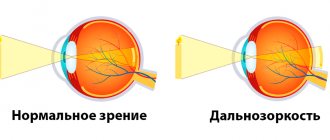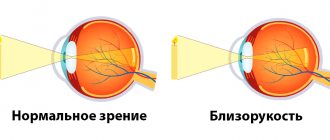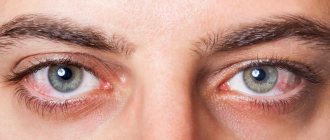- Types of neurotic disorders
- Signs of neurotic disorders
- Psychotherapy for neurotic disorders
What is a neurotic disorder
What is a neurotic disorder? It is a heterogeneous group of dysfunctions that arise as a result of acute or chronic psychological trauma. Symptoms are varied, but maladaptation, phobias, asthenia, obsessions and somatovegetative disturbances are always noted. A person's physical and mental abilities are temporarily weakened. Self-awareness and criticism persist. The diagnosis is made based on complaints, medical history and the person’s life history. To eliminate the problem, they resort to psychotherapy and medication.
Neurotic disorder is characterized
Doctors mean by neuroses a group of pathologies that arise due to the influence of mental trauma. A neurotic disorder is characterized by a deterioration in well-being, mood swings are noted, and somato-vegetative symptoms appear. In severe cases, suicidal thoughts are possible.
Causes of neurotic disorders
Doctors have different opinions regarding the catalyst for neuroses. Some believe that this condition develops due to a genetic predisposition, others – childhood psychological trauma. Children's psyche is weak, their memory is tenacious, any serious stress persists for a long time. Most of the complexes that a person suffers from in adulthood arose in childhood. Women are more susceptible to the disease.
Other causes of neurotic disorders:
- unfavorable environment, poor living conditions;
- prolonged physical overload in combination with stress;
- exhaustion of the nervous system;
- too busy work schedule;
- lack of proper rest;
- alcohol and drug abuse.
Neurotic dysfunctions occur when the body is exhausted.
Consequences of exhaustion
Asthenic neurosis
Asthenic neurosis occurs when there is an internal conflict between “should” and “can”.
At the same time, you demand more from yourself than your body can handle - work more, sleep less. As a result, the body refuses to obey, you cannot even carry out your usual tasks. This ends either with a visit to a psychiatrist or with a somatic illness.
Somatic diseases and symptoms
You may experience chronic pain (spinal pain, headache), as well as complications of viral diseases (bronchitis, pneumonia).
By overloading yourself, you can become seriously ill. Illnesses caused by distress include:
- Heart attacks;
- Strokes;
- Hypertension;
- Tachycardia;
- Gastritis and stomach ulcers;
- Disorders of the thyroid gland;
- Bronchial asthma.
Psychotic conditions
Due to lack of sleep and rest, symptoms of psychosis may occur. Hallucinations often occur with sleep deprivation.
Classification of neurotic disorders
Disorders are divided into 3 groups:
- hysterical;
- obsessive states;
- asthenic.
This classification of neurotic disorders is not similar to practice. It does not contain approved certain and most common pathologies. The differences lead to different ways of systematizing disorders.
Types of neurotic disorders
When making a diagnosis, doctors take into account the following types of neurotic disorders.
- Anxious-phobic. The main symptom is a sharp increase in anxiety and the appearance of obsessive fears. This group includes panic attacks, simple and complex phobias, and generalized anxiety disorder.
- Obsessive-compulsive. The main symptom is the appearance of obsessive ideas and actions.
- Asthenic disorders are characterized by asthenic syndrome.
- Somatoform. Clinically, they are similar to somatic ones, but do not imply a physical basis.
- Dissociative disorders imply disorders of motor function and sensations. Previously, this disease was classified as hysterical neuroses.
The sooner the patient seeks help, the more favorable the prognosis.
Forms of neurotic disorders
There are such forms of neurotic disorders.
- The most common is neurasthenia; it is divided into 3 stages. The first phase is characterized by irritability. Mental and physical abilities are not affected. The second stage is characterized by a decrease in working capacity, a person understands this. The third phase is manifested by lethargy, reluctance to do anything, and asthenic syndrome.
- Hysterical neurosis is the second form. The disease is caused by inappropriate behavior; the person is unpredictable and extremely irritable. There are signs such as seizures, paresis, vomiting, hypotension. The patient also complains of obsessive thoughts, a “lump” in the throat, and insomnia. During an attack, a person screams, lies on the floor, can get into a fight, or injure himself.
- The third form is depressive neurosis. It is characterized by symptoms such as insomnia, bad mood, loss of the ability to feel joyful emotions, a feeling of burden, and tearfulness. There are also disturbances in heart rhythm, stomach function, slow reaction to events, sexual dysfunction, and hypotension. The patient complains of despondency, sadness appears, and a feeling of uselessness.
- Obsessive states. With it, the patient is unable to control his thoughts and actions.
- Hypochondriacal neurosis - there is a fear of a circumstance from which a person cannot find a way out, or a fear of falling ill with an incurable pathology. The condition is complemented by hysteria and obsessions.
Each form requires an individual approach to therapy.
Neurotic disorders in adults
Neurotic disorders in adults have a reversible, relatively mild course, unlike psychoses. According to statistics, the problem is detected in 20% of the population. The causes include a disorder of brain activity responsible for human adaptation. Somatic and mental disturbances appear. Patients are rarely admitted to the hospital; conservative methods are usually successful.
Neurotic disorders in children
In children, the catalyst for the development of neurosis is delays in personality development. Against the background of separation from parents, stress, loss of a loved one, psychological trauma is possible. A child who experiences these situations becomes infantile or acquires neurosis.
Neurotic disorders in children: features of occurrence and course.
1. The age of 7-11 years is considered the affective stage of personality formation. If at this time the child encounters a traumatic factor, his development as a person may be delayed. In adulthood, such people experience emotional instability; a person cannot adequately assess the situation or think about the consequences. The only and beloved children acquire hysterical traits.
2. At the age of 11-14, a teenager learns to independently assess the situation, analyze, and plan his actions. There is a subsequent development of the affective component of the personality. If at this age a stressful situation arises, neuroses are possible in the future. Such teenagers outwardly look older than their peers and are more reasonable, but subconsciously, the synchronicity of personality development is disrupted.
Attention! The most important role in the successful growth of a child is played by the relationship with parents. Those who felt overprotected in childhood and were not allowed to make their own decisions become timid and unsure of themselves. It is in this category of people that neurotic disorders arise.
Forms and symptoms
In the process of its development, neurasthenia goes through several phases, each of which has its own signs and distinctive features. In some cases, one of the phases exists in isolation, which makes it possible to distinguish it into a separate form of the disease. In the future, she can move on to the next or previous stage, or even pass completely.
Regardless of the phase, the patient may encounter problems characteristic of neurasthenia:
- increased heart rate;
- feeling of strong heartbeat;
- pressing or stabbing pain in the chest;
- increased blood pressure;
- paleness of the face or, conversely, redness;
- digestive problems: heartburn, belching, bloating, constipation or diarrhea;
- frequent urge to urinate under stress;
- decreased libido, sexual disorders (premature ejaculation, impotence, anorgasmia).
Each of these symptoms can appear alone or in combination with others.
Hypersthenic form (phase)
This form is manifested by excessive irritability and emotional instability. Any little thing can make a person angry: loud noise, extraneous conversation, a large crowd of people or a seeming lack of attention from others. As a result, the patient begins to scream, curse, or insult at the slightest provocation.
Performance in this phase suffers significantly due to severe inattention. The person does not feel tired, but it is very difficult for him to concentrate on the process. He collects his thoughts for a long time, and then is constantly distracted by some extraneous irritant. The vicious circle is repeated dozens and even hundreds of times during the day, which significantly affects the result, making the person even more nervous.
Characteristic symptoms of the hypersthenic phase are:
- sleep disorders: prolonged falling asleep, frequent awakenings during the night, nightmares;
- feeling tired and tired in the morning;
- drowsiness during the day;
- pressing headache like a helmet or a subjective feeling of heaviness in the head;
- decreased attention and memory;
- discomfort inside the body (in the area of the heart, stomach, intestines, etc.).
Irritable weakness
This is the second phase of neurasthenia, which develops if the provoking factors have not been eliminated. Outbursts of anger, rage and irritation continue to arise at the slightest provocation, but they quickly fade away, leaving behind complete mental exhaustion. Often the attack ends in apathy and tears.
The patient's ability to work continues to deteriorate. He hardly forces himself to start doing anything, but almost immediately stops due to severe fatigue and headache. Attempts to finish the task can be repeated several times throughout the day and, ultimately, exhaust the person. He feels immense weakness, fatigue and weakness to the point of complete exhaustion.
The phase of irritable weakness can develop independently. People with an explosive, emotional temperament (cholerics) or initially strong, self-confident and balanced people (phlegmatics) are most susceptible to it.
Hyposthenic form (phase)
With a consistent course of neurasthenia, this phase is the final one, but anxious and suspicious people can encounter it already in the early stages of the development of the disease. Hyposthenia is characterized by:
- constant physical and mental weakness;
- apathy;
- anhedonia (loss of the ability to enjoy life);
- emotional instability, tearfulness;
- lack of interests and hobbies;
- severe hypochondria.
In fact, a person becomes fixated on himself and his asthenic state, constantly looking for signs of various diseases. During this phase, the general symptoms described above often occur, which reinforce the patient's belief in poor health.
If the factor that caused the exacerbation of neurasthenia is eliminated, or the patient is prescribed effective therapy, the disease begins to recover, no matter what phase of development it is at. Repeated attacks are characterized by greater severity of symptoms, as well as an increase in the duration of recovery.
Astheno-neurotic syndrome
Astheno-neurotic syndrome is manifested by chronic fatigue, apathy, increased fatigue and irritability. This disease is complemented by loss of appetite and insomnia. Physical signs are associated with apparent heart disease. It may seem to a person that he has a slow heartbeat, or vice versa – tachycardia. No changes are observed on the cardiogram. However, the patient feels pain in the heart muscle. Stomach problems and migraines are also possible. Diagnostics involves interviewing and examining a person. An examination is being carried out for a viral infection. The prognosis is favorable, especially if the person additionally attends art therapy sessions. Drawing has a relaxing effect on the psyche, negative thoughts dissipate, and the patient feels harmony.
Causes of burnout syndrome
It is generally accepted that teachers, as well as doctors and medical staff, are more susceptible to emotional burnout than others. However, even students, pensioners and housewives can suffer from it. After all, emotional exhaustion is not always associated with work; it can also be caused by too heavy a burden of personal obligations.
Let us conditionally divide the causes of this syndrome into personal and external.
- Personal causes of burnout.
Individual resilience and coping skills certainly play a role, but just because a person is very resilient to stress doesn't mean they're immune to burnout. It can affect both people who lack self-confidence and those who are confident, determined and full of energy.
Here are some of the internal reasons:
- overly ambitious and unrealistic goals;
- perfectionism;
- inability to say “no”;
- difficulty expressing feelings;
- Ignore your own needs and instead strive to meet the needs of others;
- poor adaptability;
- constant stress in your personal life;
- lack of rest;
- too high demands on yourself.
- External causes of burnout.
Both the workplace and society can exert significant pressure. Likewise, a difficult life episode or any other major change can lead to burnout.
Some of the possible external causes are:
- pressure at work (for example, the call to do everything faster);
- lack of incentive or overwork;
- lack of recognition and support;
- conflicts and bad atmosphere in the company;
- discrimination or intimidation;
- high competitive pressure;
- too many responsibilities;
- difficulty meeting deadlines;
- lack or absence of autonomy.
Burnout often occurs as a result of a clash of personal factors and external causes. Over time, all of these stresses weaken the immune system and are considered triggers for chronic fatigue syndrome (CFS).
Dysthymia – depressive neurotic disorder
The disease is characterized by a depressed state in the patient, which does not go away for more than 2 years. The pathology is characterized by decreased vital energy and increased fatigue. A person feels apathy and is unable to enjoy life. Self-esteem decreases and self-confidence is lost. Such people rarely share their emotions with others. The most severe consequence is suicide. The patient is referred to a psychotherapist. With timely treatment, dysthymia, or depressive neurotic disorder, is treatable.
Symptoms of neurotic disorders
Neurotic dysfunctions are characterized by instability of mood and rash actions. Patients suffer from memory impairment, problems with concentration, and a number of other clinical manifestations:
- causeless psychological stress;
- increased fatigue;
- sleep problems;
- isolation;
- fixation on problems in life;
- memory impairment;
- dizziness;
- fainting;
- migraine;
- pain in the heart muscle and joints;
- frequent urination;
- excessive sweating;
- decreased potency;
- high or low self-esteem;
- inconsistency, uncertainty;
- tearfulness;
- aggressiveness;
- suspiciousness;
- poor prioritization.
Symptoms of neurotic disorders are often complemented by increased sensitivity to light, sound, and reactions to minor temperature changes.
Signs of neurotic disorders
Signs of neurotic disorders vary by gender. In women, asthenic neurosis more often appears, characterized by aggressiveness, loss of mental and physical ability, and lack of sexual desire. During intimacy, it is impossible to relax. A woman suffering from asthenic neurosis quarrels with relatives and often loses her temper over trifles. Constant tension is fraught with the development of diseases of internal organs.
In men there are the following types:
- depressed – a person is not able to realize himself in the world of work, or adapt to sudden changes in any area of life;
- male neurasthenia - usually appears after physical or moral overstrain; workaholics are susceptible to this type.
Men and women over 45 years of age are prone to these types of diseases. They may still have problems with the functioning of their internal organs.
Neurotic disorder syndrome
The syndrome of neurotic disorders is a reflection of a traumatic circumstance and is often combined with other neurotic manifestations. The patient's mood decreases, but there is no feeling of melancholy. Usually, a bad mood is combined with emotional lability, asthenia, mild anxiety, loss of appetite and insomnia. During the day, no special fluctuations are observed, or they are mild. Mental and motor retardation, self-flagellation, and suicidal thoughts are not typical.
- Neurotic depression is distinguished from reactive depression, which is also caused by traumatic circumstances. In the second type, the symptoms reach the level of reactive psychosis - the patient is depressed, inhibited, consciousness is narrowed, and thoughts of suicide appear.
- In the case of psychotic depression, the patient wishes to die, there is gross disorientation of the personality with separation from life, sudden anosognosia, delusional ideas of self-humiliation, manic episodes. The condition can be controlled with antidepressants and a repeated course of treatment.
- Neurotic depression is characterized by the preservation of the basic personality qualities, the patient is aware of his condition. Obsessive phobias and pronounced hysterical manifestations appear.
Important! Psychotic depression is more dangerous for a person and requires immediate treatment.
Levels of neurotic disorders
Neurotic disorders occur at 3 levels: as a manifestation of individual symptoms, at the level of minor syndromes, and as specific disorders.
Levels of neurotic disorders.
- Individual symptoms. They are also present in those who do not suffer from mental disorders.
- A minor emotional disorder can be complemented by several neurotic syndromes, of which the leading one is not identified.
The patient population consists of 2 types:
- some suffer from an acute, short-term stress reaction;
- others experience long-term, chronic impairment.
Most patients recover within six months, while others recover in no less than 3 years.
A little test to test yourself
Emotional burnout is an extremely unpleasant condition that can lead to the development of all kinds of somatic and psychological ailments. The problem with diagnosis is that people often attribute the symptoms of the syndrome to banal fatigue and do not take them seriously.
The method for assessing emotional burnout, the Maslach questionnaire, is one of the most popular and reliable for assessing one’s own mental state. Diagnosis is carried out according to the main features - emotional exhaustion, depersonalization, reduction of professional achievements.
The questionnaire consists of 22 questions, for each of which you must select one answer option.
| Question no. | Question | Answer options |
| 1. | I feel pleasantly revitalized while working | Never – 0 points Very rarely – 1 point Rarely – 2 points Sometimes – 3 points Often – 4 points Very often – 5 points Every day – 6 points |
| 2. | I can find the right solution in conflict situations that arise when communicating with colleagues | |
| 3. | After work I feel like a squeezed lemon | |
| 4. | After work, I want to get away from everyone and everything for a while | |
| 5. | At work I deal with emotional problems calmly | |
| 6. | I notice that my job is making me bitter | |
| 7. | Lately, it seems to me that colleagues and subordinates are increasingly shifting the burden of their problems and responsibilities onto me | |
| 8. | I want to retire and take a break from everything and everyone | |
| 9. | I feel emotionally drained | |
| 10. | I feel depressed and apathetic | |
| 11. | It happens that I really don’t care what happens to some of my subordinates and colleagues | |
| 12. | I feel like I'm working too much | |
| 13. | In the morning I feel tired and reluctant to go to work | |
| 14. | Lately I've become more callous towards those I work with. | |
| 15. | I feel indifference and loss of interest in many things that made me happy in my work | |
| 16. | I feel like I treat some subordinates and colleagues like objects (without warmth or affection towards them) | |
| 17. | I can easily create an atmosphere of goodwill and cooperation in a team | |
| 18. | I understand well how my subordinates and colleagues feel, and I try to take this into account in the interests of the business | |
| 19. | I have many plans for the future and I believe in their implementation | |
| 20. | Thanks to my work, I have already done a lot of really valuable things in my life. | |
| 21. | I'm sure people need my work | |
| 22. | My job is increasingly frustrating me |
Decoding the results on the scale of emotional exhaustion - a feeling of emptiness, lethargy, the meaninglessness of what is happening, lack of positive emotions, mental and physical fatigue:
- 0-15 points – low level
- 16-24 – average level
- 25-54 high level.
Decoding the results on the depersonalization scale - indifference to work and its results, colleagues, partners, clients, lack of personal involvement:
- 0-5 points – low level
- 6-10 points – average level
- 11-30 points – high level
Decoding the results on the scale of reduction of professional achievements - decreased motivation to work, a negative assessment of one’s work in general and its results in particular, dissatisfaction with responsibilities, avoidance of them:
- 0-11 points – low level
- 12-18 points – average level
- 18-48 points – high level
If emotional burnout syndrome is not stopped in time, then its continuously increasing influence can significantly worsen the quality of life and lead to serious psychological problems and somatic diseases.
Diagnosis and treatment of neurotic disorders
A person should contact a psychologist or psychotherapist. Diagnostics requires an integrated approach.
The color technique is widely used.
- All shades take part in it. Neurosis-like syndrome is noted when a person selects or repeats gray, purple, brown or black.
- With hysterical neurosis, the patient chooses 2 colors - purple and red. This also indicates low self-esteem.
To determine the symptoms, a test is carried out - it makes it possible to identify the presence of chronic fatigue, anxiety, and self-doubt. Diagnosis and treatment of neurotic disorders are closely interrelated.
Drug therapy is used in the first stages to relieve internal tension and eliminate insomnia. Antidepressants and tranquilizers are widely prescribed. Depending on the severity and duration of the clinical picture, the doctor prescribes drugs from different groups to the patient:
- non-selective – Amitriptyline, Imipramine;
- selective influence - Maprotiline, Fluoxetine;
- sedative antidepressants – Doxelin, Azafen;
- balanced – Sertalin, Tryptophan;
- stimulants - Heptral, Bupropion.
Obsessive states are well relieved by drugs from the SIDS group - Prozac, Paroxetine, Escitalopram. Frequently prescribed tranquilizers include Phenazepam, Tofisopam, Meprobamate. All medications are prescribed in a short course of 5-7 days, sometimes extended to 10.
Important! If a person self-prescribes medications, the disease may transform and the condition may worsen.
Psychotherapy for neurotic disorders
To achieve maximum effect, doctors recommend supplementing drug treatment with rational, cognitive psychotherapy. The main objective of this technique is to eliminate the consequences of a stressful situation so that the general condition of a person improves and the symptoms of neurosis are eliminated. The doctor discusses the cause of the problem and works through the traumatic circumstances. The patient learns relaxation techniques, the ability to level out negative emotions and complexes. The most difficult thing to eliminate is negative attitudes given by parents. A person must show his will, diligence, and do his homework. Typically, psychotherapy for neurotic disorders consists of 7-15 sessions, depending on the degree of complexity of the problem. In severe cases, the patient is admitted to the department of borderline mental disorders.
Treatment at the Energy of Health clinic
If stress and fatigue are the cause of loss of strength, the doctors at the Health Energy clinic will come to the rescue. First, we conduct a detailed examination that will help exclude other causes of pathological symptoms, and prescribe consultations with specialized specialists and tests necessary to assess the situation. Then you will be offered comprehensive treatment, which includes:
- individual selection of medications in accordance with the symptoms and characteristics of the body;
- modern psychotherapeutic techniques;
- physiotherapy, massage, physical therapy to stabilize the condition;
- organization of sanatorium-resort treatment.
Prevention
It is possible to prevent the development of neurotic disorders by leading a healthy lifestyle. It is important to sleep 7-8 hours a day, go to bed before 1.00, resolve internal conflicts in a timely manner, and avoid stress. If a person’s work involves difficult situations or psychological overload, it is worth thinking about changing the sphere of work.
Prevention of neuroses: effective tips.
- Do not abuse alcohol or smoking. Intoxication provokes a deterioration in adaptive capabilities, and various diseases appear. When drinking alcohol regularly, the psyche suffers and a severe hangover occurs.
- The food menu should always include a lot of vegetables, fruits, lean meats and fish. It is advisable to rely on dairy products and take a course of vitamins in the off-season. Overeating is also dangerous; you need to consume food in moderation.
- Music. This is an effective prevention method that involves listening to calm melodies. This could be the sound of rain or sea, falling snow and other natural phenomena. You should listen to soothing music before bed, or after a stressful situation. It can be found on YouTube, social networks, it is advisable to record it on a smartphone so that you can always relax.
- It is important to exercise in moderation. Physical activity is the key to mental health. It is advisable to do exercises every morning or evening, you can join a gym, go to the pool 2-3 times a week.
- Plan your actions, act according to the plan. Then there will be fewer stressful situations if a person does not let everything take its course.
- Treat all diseases in a timely manner. Regular pain causes emotional stress.
- It should be remembered that family conflicts, especially constant ones, cause serious stress. Family is the rear, not the battlefield. If there are problems in your personal life and they are not resolved, it is better to change your partner.
If it was not possible to prevent neurosis, you need to seek help in a timely manner. Then the chances of leveling out the negative psychological state are maximum.
What happens if a neurotic disorder is not treated?
Neuroses can cause complications if left untreated. Many people ignore therapy and do not go to doctors. Post-Soviet stereotypes that going to a psychotherapist is shameful still live in people’s heads. Such negligence entails irreversible changes in the psyche.
What happens if a neurotic disorder is not treated:
- increased symptoms;
- the patient becomes hysterical and hypersusceptible;
- self-esteem suffers;
- other chronic diseases appear;
- the risk of catching a cold increases;
- the formation of an explosive personality that does not tolerate returns, is aggressive, and concentrates only on the negative.
A person becomes a hypochondriac, his personality is destroyed. The last stage is caused by complete apathy, the person does not get out of bed, and may refuse food. The patient is no longer able to do without medications or control his emotions. High risk of suicide. It is extremely difficult to treat this condition; it can lead to more serious mental pathologies. You cannot do without long-term psychotherapy, taking medications and staying in a neurosis clinic.
General information about neurasthenia
The term “neurasthenia” is derived from two Latin roots and is translated as “weakness of the nerves.” The disease is often found in developed countries with an intense and stressful pace of life. It affects people aged 20 to 50 years. On average, every tenth adult notices certain symptoms of neurasthenia, and in women they are somewhat less common than in men.
The manifestations of the disease, at first glance, seem harmless; many are sure that the person cannot pull himself together and concentrate. In fact, the roots of the problem lie much deeper, and without the help of a doctor or at least a psychologist, it can be difficult to cope with it. Long-term neurasthenia significantly worsens the quality of life, depriving a person of the opportunity to enjoy anything, work effectively and feel confident and calm.
Make an appointment








